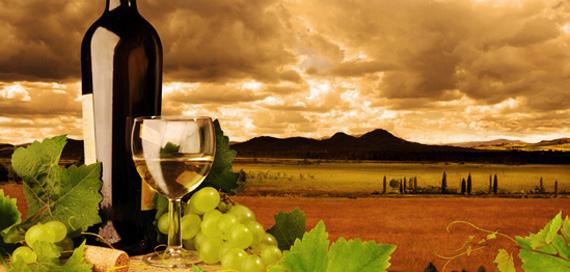New to wine?
How wine is made

Harvest
The vineyards are a critical determinant in the end product wines for each and every vintage. Vineyards are like the wine’s bassinets, where early grapelife begins and flourishes, for all wine is truly birthed on the vine. The vineyard’s location, climate, terrain, soils, vines and rootstocks, irrigation systems and pest management controls all factor into the final product in one way or another. Sun exposure and time on the vine both play a key role in the grape’s development and specific sugar levels.
Winemaking commences with the annual grape harvest and can be accomplished by either mechanical harvesting equipment (usually easiest for vineyards that lie on relatively flat land) or hand-harvesting. Hand-harvesting affords more precise selection and often does a better job of protecting the grape’s juice content from oxidation due to damaged skins. Mechanical harvesters offer a more efficient, often cost-effective, process and are wellsuited for large vineyards that lay on a flat patch of earth. The type of harvest – handpicking, mechanical harvesters or a combination of the two – is largely influenced by the winemaker’s final wine style goals as well as budget.
Crushing and Destemming
After the grapes have been harvested it is often a mad dash to get them crushed and destemmed. The objective of crushing is not necessarily to squeeze all of the juice out of the grape, but to split the external skin and allow the juice to start its run, giving the sugar from the juice its first chance to mingle with the natural yeast found on the grape’s skin. It is the combination of yeast and sugar that produces the wine’s alcohol, via the yeast converting the sugar to alcohol and carbon dioxide. The ‘crush’ happens in one of two ways – again by mechanical means with a heavy spiraled steel roller or the more traditional approach that you see in all of the fun Italian wine-themed movies – the famous grape ‘stomp’.
At this point the grape stems are separated from the juice, or ‘must’ as it is referred to at this phase in the game. This is also the juncture where red wine grapes and white wine grapes take different paths. If a wine is destined to be a red wine then it is the grape skin (not the juice, which is virtually clear) that provides the colour characteristics and the tannin contributions for a red wine. However, if the goal is a white wine, then the grape skin is removed along with the stems at this phase of the process and the grapes are pressed prior to fermentation.
Wine Fermentation
Fermentation is the phase in the winemaking process that really gets wine going on its path to its ultimate destination ... the bottle! It is during fermentation that the grape’s sugars are converted to alcohol (specifically ethyl alcohol) and carbon dioxide, along with a good bit of residual heat that needs to be monitored to prevent distortion of flavours. The process of red wine fermentation typically takes place in stainless steel tanks, large vats or oak barrels. Maceration is basically the contact phase, where the must and the grape skins have maximum contact to produce good red wine colour, structural tannins and extensive flavour components and nuances. The more the red wine grapes are in contact with their grape skins, the ‘bigger’ the wine will likely be.
White wine fermentation often takes place in stainless steel tanks with lower heat levels that are closely monitored and the oxygen levels strictly guarded (to prevent rapid oxidation). Chardonnay is one exception, some winemakers prefer to hold the Chardonnay juice in sealed oak barrels for fermentation to influence flavour development.
If during the fermentation process the grapes were not quite ripe enough, sugar may be added to the must to increase alcohol levels in the final product, this addition is referred to as ‘enrichment’. Likewise, acid can also be added to the must if the acidity is low, this is understandably referred to as ‘acidification’. Also with white wine fermentation an additional step referred to as ‘stirring the lees’ is added. This step involves mixing up the residual yeast that is left post fermentation to yield more flavours.
Pressing
Pressing, usually done right after the crush for white wine grapes and after fermentation for red wine grapes, is basically taking the sticky grape solids left from either the crush or fermentation and squeezing them to get a very thick liquid that can be used to enhance both colour and flavour of the presumptive wine to be.
Malolactic Fermentation
Malolactic fermentation is a process in which lactic acid bacteria converts the harsher malic acids (think green apple pucker) in the juice into lactic acid (think creamy milk) to produce a softer mouth feel and overall a more inviting palate presence. Most red wines go through malolactic fermentation to reduce their acidity and some fuller bodied white wines are sent through malolactic fermentation (usually in the barrel) to mellow them out a bit more.
Maturation
The maturation phase of winemaking essentially represents the home stretch of the wines journey from vine to bottle. When you think of the wine maturation process, inevitably traditional oak barrels come to mind and for good reason, both French and American oak, are the most common containers for the maturation process to take place. Oak offers protection, imparts flavour and allows tiny amounts of oxygen to penetrate via the staves to both ease the tighter tannins in a red wine and create flavour complexity in both red and white wines.
The other option for maturation is a stainless steel tank. This option is becoming increasingly popular as they are inert, economical because they do not need to be replaced after so many years in the rotation and they are very easy to maintain. To compensate for the lack of oak in the stainless steel tanks, some producers supplement the process by adding oak chips to the juice shooting for the ‘oak effect’.
Racking is the process of moving the juice from one barrel to another, providing two key benefits: the juice is separated from the bottom layer of sediment, which could negatively impact the final flavour; and the wine undergoes a bit of aeration to open up flavours and allow for further development.
Finishing: Fining and Filtration
The finishing process involves several critical components. First, the fining and filtering of the wine (collectively referred to as ‘clarification’) remove the vast majority of the unwanted particulates still residing in the wine. Often egg whites are used in the fining phase to bind up tiny floaters in the wine and weigh them down so that they end up on the bottom of the barrel and can be separated from the wine. Filtration is the process of removing bigger solids like dead yeast cells and other particles, so that the wine is no longer cloudy, but bright and clear, as a consumer would expect.
Blending Wines
Blending wine can be as simple as taking two separate wines and mixing them together to complicating things a bit by taking multiple varietals from multiple regions and blending them to make a new wine with a unique flavour experience. It likely goes without saying, that it takes a lot of experience and a very refined palate to successfully blend wines for today’s worldwide market. A winemaker may blend wines for a variety of reasons: to adjust pH, acidity, alcohol levels, tannin content or to improve colour, aroma or flavour.
Bottling Wine
Finally, the bottling phase of winemaking – the end is in sight! Bottling wines today is done through mechanical bottling lines. Smaller wineries might rent bottling rigs that can be tranported to the winery for the season, while the larger estates have their bottle lines on-site. As far as the actual process, the wine bottle is slowly filled and topped with either nitrogen or carbon dioxide to displace any oxygen that might be lingering on top of the fill line. The bottle is then capped with either a traditional cork or a modern screw cap, depending on the winery’s traditions and philosophies. Next the bottles have their unique feature labels slapped on and away they go for either further bottle aging or straight to the case for distribution.




